Within the team there is an increased interest in obtaining and developing nanocomposite materials both from a fundamental and applied point of view. The technological applications addressed are: environmental protection, energy storage, photodynamic therapy, contrast agents in medical imaging, magnetic hyperthermia, exchange-coupled micromagnets, etc.
Themes initiated / developed: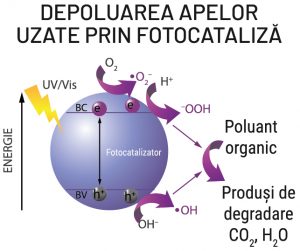
- The study of interface phenomena in composite nanostructured materials:
- -spin and charge transfer
- -quantum magnetic coupling processes at the interface.
- The study of photocatalytic processes in composite nanostructured materials.
- Photogeneration processes in composite materials and thin films.
- The study of the generation of reactive oxygen species by spin traps coupled with RES technique.
- Coupling processes in nanostructured magnetic composites.
- Magnetic and photothermal hyperthermia therapy.
Areas of expertise:
- Expertise on chemical preparation (MC) and pulse laser deposition (PLD)

- Nanocomposites based on semiconductor and/or magnetic materials, with adjustable composition and characteristics used in environmental protection (MC)
- Composite materials used as electrodes for all-solid-state supercapacitors applied in energy storage
- Nanocomposites based on carbon structures decorated with semiconductor nanoparticles (MC)
- Exchange coupled magnetic materials with applications in energy storage (MC, PLD)
- Semiconductor thin films used in the production of electricity by photovoltaic effect obtained by PLD
- Ferromagnet/semiconductor multilayer thin films obtained by PLD
- Biofunctionalized magnetic nanocomposites in various architectures with medical applications (MC)
- Expertise regarding the characterization of nanostructures:
- Quantitative and qualitative compositional analysis by high resolution photoelectron spectroscopy (XPS).
- The study of conduction or valence bands by UV-excited photoelectron spectroscopy (UPS)
- Structural characterizations by X-ray diffraction (powders and thin films)
- Magnetic characteristics; maximum field 8T, temperature range 3 – 300 K (VSM, SQUID)
- Local structures, electronic and spin dynamic characterization of paramagnetic systems by electron paramagnetic resonance (RPE)
- Photocatalytic properties evaluation
- Optical properties characterization by UV-Vis and Photoluminescence spectroscopies
Team Leader
Dr. Ioan Ovidiu PANĂ – Leading Researcher (R4)
Expertise: Materials science, nanoparticles, nanocomposites.
Members:
Dr. Ameen Uddin AMMAR – First Stage Researcher (R1)
Expertise: Materials Engineering.
Maria GROZA – Senior Technician (TS)
Dr. Maria Simona GUŢOIU – Recognised Researcher (R2)
Expertise: Material Science, Chemistry, Chemistry Physics, Applied Physics.
Dr. Cristian LEOŞTEAN – Established Researcher (R3)
Expertise: Materials science, nanoparticles, nanocomposites.
PhD student eng. Gabriel Sergiu MACAVEI – Technology Development Engineer I
Expertise: XRD,AFM/STM,PLD SYSTEM Development and design of measurement systems and characterize nanoparticles and thin films.
Drd. Karlo MASKARIC – Scientific Research Assistant (ACS)
Expertise: Spectroscopic Techniques.
Drd. Ion NESTEROVSCHI – Scientific Research Assistant (ACS)
Expertise: Spectroscopic Techniques.
Dr. Adriana Paula POPA – Established Researcher (R3)
Expertise: Electron Spin Resonance, Nanomaterials, Photocatalysis.
Dr. Árpád ROSTÁS – Recognised Researcher (R2)
Expertise: Electron Paramagnetic Resonance, Supercapacitors.
Dr. Teofil-Dănuţ SILIPAŞ – Established Researcher (R3)
Expertise: .
Dr. Manuela Cristina STAN – Recognised Researcher (R2)
Expertise: Analytical Chemistry, Organic Chemistry, Nanomaterials.
Dr. Maria Viorica ŞTEFAN – Established Researcher (R3)
Expertise: Materials Science and Engineering, Nanomaterials, Inorganic Chemistry, Photocatalysis.
Dr. eng. Ramona Crina SUCIU – Recognised Researcher (R2)
Expertise: Materials Science and Engineering.
Dr. Dana Aurica TOLOMAN – Established Researcher (R3)
Expertise: Electron Spin Resonance, Nanomaterials, Photocatalysis.
Phd. student Ana VARADI – Scientific Research Assistant (ACS)
Expertise: Metal oxides preparation.
ZnxFe3-xO4@ ZnO heterojunction interfaced with poly(L-DOPA) electron transfer mediator layer for enhanced visible light photocatalytic activity

Ovidiu Pană, Anca Petran, Adriana Popa, Maria Ștefan, Teofil Dănuț Silipaș, Cristian Leoștean, Bogdan Stefan Vasile, Florina Pogăcean, Dana Toloman
Journal of Alloys and Compounds, 986, 2024, 174168
Z-scheme heterojunctions comprising ZnxFe3-xO4@poly(L-DOPA)@ZnO (ZF@PD@ZnO) were synthesized using solvothermal and precipitation techniques. The study aimed to investigate the impact of the poly(L-DOPA) electron transfer mediator on the photocatalytic performance of ZnxFe3-xO4@ZnO (ZF@ZnO) nanocomposites under visible light irradiation. X-ray diffraction (XRD) and HRTEM analysis confirmed the formation of heterostructures, identifying the crystalline phases of both ZnO and zinc ferrite. BFTEM images revealed a polyhedral shape for all samples, with a tendency toward mild agglomeration. The partial inversion of the zinc ferrite cubic spinel structure was evidenced by FT-IR, XPS, and VSM analyses. Zinc ferrite was found to be ferromagnetic, with cation distributions between tetrahedral (A) and octahedral (B) positions as . The samples exhibited notable photocatalytic activity against Rhodamine B, serving as a model contaminant. Furthermore, the stability and reusability of the samples were examined. Additionally, the study elucidated the photocatalytic mechanism produced by the ternary Z-scheme ZF@PD@ZnO, involving spin-polarized charge carriers. Energy band alignment was evaluated by combining ultraviolet photoelectron spectroscopy (UPS) with UV-Vis spectroscopy. The interplay between band alignment and reactive oxygen species (ROS) generation was discussed in correlation with EPR results. Enhanced ROS generation under visible light illumination, observed in the ZF@PD@ZnO nanocomposite, is mainly due to the addition of the conductive poly(L-DOPA) layer, acting as an electron transfer mediator in the Z-scheme heterojunction, ensuring enhanced charge separation.
Hybrid PVDF-P(L-DOPA)-ZnO membranes for dyes and antibiotics removal through simultaneous action of adsorption and photocatalysis processes
Adriana Popa, Dana Toloman, Maria Ștefan, Anca Petran, Sergiu Macavei, Sorin Ulinici, Manuela Stan, Lucian Barbu-Tudoran, Mihaela Vlassa, Ovidiu Pană
Journal of Journal of Environmental Chemical Engineering, 9(6), 2021, 1068
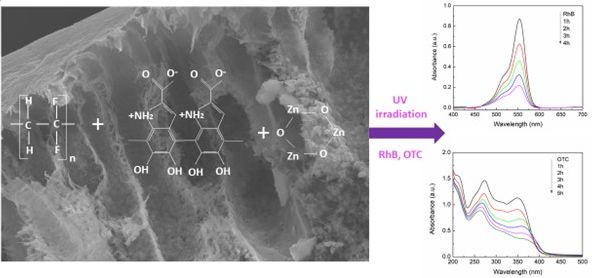 PVDF-P(L-DOPA)-ZnO hybrid membranes were prepared with the purpose to eliminate several classes of pollutants from water: cationic dyes and antibiotics. The PVDF membrane with the pores mean size of 1.5 µm was prepared by the phase inversion method. P(L-DOPA), a PDA analogue, was deposited on the polymeric membrane to facilitate the anchor of in-situ grown ZnO nanoparticles. Several characterization methods were deployed to explore the hybrid membranes’ structural, morphological, optical, and photocatalytic properties. The firm P(L-DOPA)-ZnO coating on the PVDF membrane surface converted its hydrophobic nature to a hydrophilic one. For an optimal ZnO nanoparticles amount and size, efficient degradation of Rhodamine B (RhB- 80%) and oxytetracycline (OTC-71%) was obtained in 5 h of UV-light irradiation. The generation of P(L-DOPA)-ZnO Z-scheme photocatalyst promotes an efficient separation of photoinduced electron-hole pairs beneficial to photocatalytic activity. The hybrid membrane revealed similar photocatalytic activity after 3 cycles illustrating high stability. The analysis of the generated reactive oxygen species correlated with radical spin trapping experiments suggest that photogenerated h+ play the main role in the photodegradation of both studied pollutants.
PVDF-P(L-DOPA)-ZnO hybrid membranes were prepared with the purpose to eliminate several classes of pollutants from water: cationic dyes and antibiotics. The PVDF membrane with the pores mean size of 1.5 µm was prepared by the phase inversion method. P(L-DOPA), a PDA analogue, was deposited on the polymeric membrane to facilitate the anchor of in-situ grown ZnO nanoparticles. Several characterization methods were deployed to explore the hybrid membranes’ structural, morphological, optical, and photocatalytic properties. The firm P(L-DOPA)-ZnO coating on the PVDF membrane surface converted its hydrophobic nature to a hydrophilic one. For an optimal ZnO nanoparticles amount and size, efficient degradation of Rhodamine B (RhB- 80%) and oxytetracycline (OTC-71%) was obtained in 5 h of UV-light irradiation. The generation of P(L-DOPA)-ZnO Z-scheme photocatalyst promotes an efficient separation of photoinduced electron-hole pairs beneficial to photocatalytic activity. The hybrid membrane revealed similar photocatalytic activity after 3 cycles illustrating high stability. The analysis of the generated reactive oxygen species correlated with radical spin trapping experiments suggest that photogenerated h+ play the main role in the photodegradation of both studied pollutants.
All-in-one supercapacitor devices based on nanosized Mn4+-doped WO3
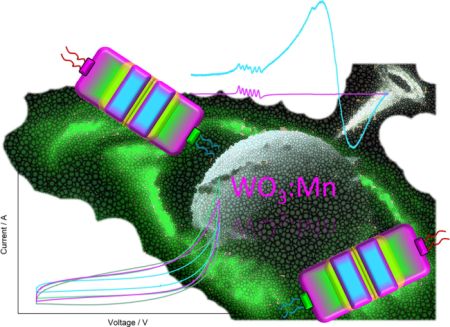
Ameen Uddin Ammar, Manuela Stan, Adriana Popa, Dana Toloman, Sergiu Macavei, Cristian Leostean, Alexandra Ciorita, Emre Erdem, Arpad Mihai Rostas
Journal of Energy Storage, 72, D, 2023, 108599
Nanosized Mn-doped WO3-based materials were used as electrode materials for high-performance supercapacitor devices. Various Mn concentrations (0.5, 1, and 1.5%) were used to change the defect structure of WO3, which improved the material’s electrical properties. A thorough morpho-structural and defect structure analysis of the undoped and doped WO3 was performed through various characterization techniques, among which EPR and PL spectroscopy gave insight into the effect that Mn-doping caused on the defect structure and optical properties of WO3. The presence of Mn4+ ions and a high concentration of oxygen vacancies was observed, strongly influencing the electrode material when used in symmetric supercapacitors, where the electrochemical performance was tested. The symmetric supercapacitors were designed without booster materials (like carbon black) and showed increased specific capacitance (115 F/g) and energy density (16 Wh/Kg) values.
Visible-light-driven photocatalytic degradation of different organic pollutants using Cu doped ZnO-MWCNT nanocomposites
Dana Toloman, Adriana Popa, Manuela Stan, Maria Ștefan, Grigore Vlad, Sorin Ulinici, Gabriela Baisan, Teofil Dănuț Silipaș, Sergiu Macavei, Cristian Leoștean, Stela Pruneanu, Florina Pogăcean, Ramona Crina Suciu, Lucian Barbu-Tudoran, Ovidiu Pană
Journal of Alloys and Compounds, 866, 2021, 159010
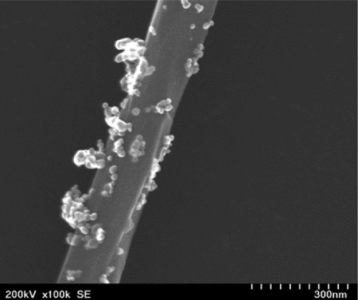
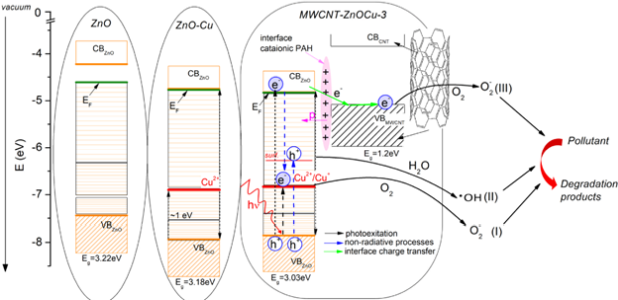
Photocatalytic degradation of organic pollutants has been established as one of the most effective and affordable technique to solve the environmental contamination issues. The present work was focused on the development of Cu doped ZnO-MWCNT nanocomposites designated for photodegradation of three water organic pollutants namely rhodamine (RhB) dye, phenol and oxytetracycline (OTC) antibiotic. The nanocomposite samples, with MWCNTs: ZnOCu weight ratios of 1:1, 1:3 and 1:5 were prepared and characterized using modern techniques. XRD revealed the presence of both MWCNT and ZnO crystalline phases in composites. The specific bands of MWCNT and ZnO composite components were highlighted by FT-IR. EPR and XPS spectroscopy showed the presence of Cu2+ ions inside the ZnO lattice. SEM and TEM images provided evidence of the attaching and distribution along the nanotubes of Cu doped ZnO nanoparticles with spherical form and diameter around 20 nm. The energy band gap of nanocomposites decreased with the increase of MWCNT amount. The PL emissions gradually quenched by increasing MWCNT content due to electron-hole recombination delays, which favors photocatalytic activity. Evaluation of nanocomposites as photocatalysts for degradation of the three types of pollutant solutions under visible irradiation demonstrated that all samples possessed photocatalytic activity. The best photocatalytic performance was acquired using MWCNT-ZnOCu-3 sample with degradation rates of 76%, 55% and 91% for RhB, OTC and phenol solutions, respectively. The mechanism of photocatalytic activity was elucidated based on the scavenger experiments, reactive oxygen species involved in this process and in correlation with energy bands alignment and gap states. The degree of mineralization of pollutant solutions obtained via total organic carbon analysis was evaluated.
New emerging magnetic, optical and photocatalytic properties of Tb doped TiO2 interfaced with CoFe2O4 nanoparticles
M. Ștefan, C. Leoștean, D. Toloman, A. Popa, S. Macavei, A. Fălămaș, R. Suciu, L. Barbu-Tudoran, O. Marincaș, O. Pană
Applied Surface Science, 570, 2021, 151172
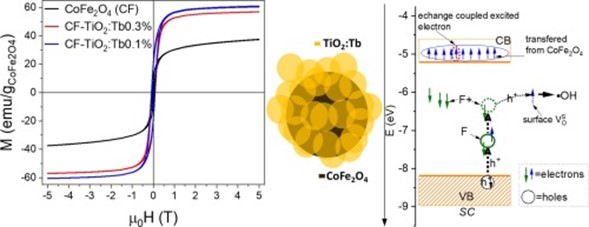
The CoFe2O4/TiO2:Tb composite nanoparticles were prepared by a two-stage chemical route. There is a polarized spin transfer at the interface between the cobalt ferrite into the TiO2 conduction band. As a result, the magnetic moments of oxygen vacancies in TiO2 becomes (ferro) magnetically ordered. The magnetic moments sublattice of Tb ions may have an either “ferro” or “antifero” coupling depending on the dopant concentration. The magnetic semiconductor intensifies the optical absorption in the visible. There is a band-to-band absorption assisted by single-occupied oxygen vacancies coupled to some local crystal lattice relaxations.
The lifetime of the photoexcited electrons in the conduction band increases due to their coupling with magnetically ordered interface transferred states. Also, the trapping of electrons into multiplet states of Tb3+ reduces the recombination rate. The photocatalytic efficiency of the magnetically ordered titania increases with respect to bare TiO2. The reactive oxygen species produced at the solid–liquid interface of TiO2 were identified by Electron Spin Resonance coupled with spin-trapping technique. The results were correlated to the presence of the magnetic order inside the titania.
Spin transfer and proximity effects in case of FePt (L10) nanoparticles coated with P3HT
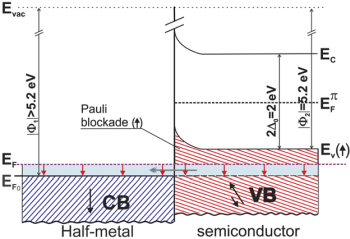 Simona Guțoiu, Cristian Leoștean, Maria-Loredana Soran, Maria Ștefan, Sergiu Macavei, Dana Toloman, Adriana Popa, Adina Stegarescu, Ovidiu Pană
Simona Guțoiu, Cristian Leoștean, Maria-Loredana Soran, Maria Ștefan, Sergiu Macavei, Dana Toloman, Adriana Popa, Adina Stegarescu, Ovidiu Pană
AIP Advances 10, 2020, 055215
Nanocomposites based on half-metallic FePt (L10) magnetic nanoparticles coated with the semiconducting conjugated polymer poly(3-hexylthiophene-2,5-diyl) (P3HT) show a significant reduction in the magnetic coercivity. This study adopts a physical approach based on chemical potential equalization at the interface. The underlying charge/spin transfer mechanism unveils an imbalance: only spin-down polarized electrons are allowed to be transferred from the semiconductor to the half-metal (spin-down) conduction band, while spin-up states remain blocked at the interface. This process determines an excess of spin-up states on the P3HT side, and due to a RKKY mechanism, this effective spin system becomes ferromagnetic polarized. Due to this proximity effect, the conjugate polymer becomes exchange coupled to the hard magnetic FePt (L10) phase, thus reducing the coercivity of the half-metal. These processes make this type of composite suitable for magnetic recording applications.
Interplay between ferromagnetism and photocatalytic activity generated by Fe3+ ions in iron doped ZnO nanoparticles grown on MWCNTs
Adriana Popa, Ovidiu Pană, Maria Ștefan, Dana Toloman, Manuela Stan, Cristian Leoștean, Ramona Crina Suciu, Grigore Vlad, Sorin Ulinici, Gabriela Baisan, Sergiu Macavei, Lucian Barbu-Tudoran
Physica E: Low-dimensional Systems and Nanostructures, 129, 2021, 114581
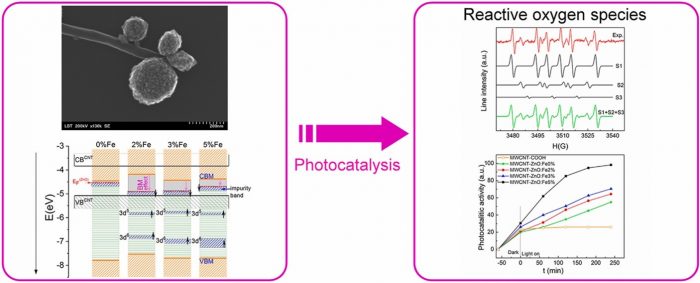 In order to limit the photogenerated charges recombination and to ensure an efficient photocatalytic degradation of RhB pollutant, a MWCNT-ZnO:Fe composite material was designed. Fe doped ZnO Nps grouped into quasi-spherical structures of about 100–250 nm were grown in situ on MWCNTs using sol-gel method. The XPS and UPS analysis allowed the identification of both Fe2+ and Fe3+ ionic species at substitutional and surface positions. The substitutional Fe3+ will generate an inverse Burstein-Moss effect and, as a result, the Fermi level is will be pushed down towards the valence band by 0.7, 0.45 and 0.29 eV for 2, 3 and 5% Fe doping respectively. The Fe doped samples show ferromagnetic behavior as determined from both ESR and magnetization measurements. The ferromagnetic order, the inverse Burstein-Moss effect, and the hole capture into the MWCNT valence band favors the charge separation of photogenerated e-h pairs and the reactive oxygen species (ROS) generation in ZnO. The proposed energy bands setup allowed to elucidate both ferromagnetic order formation and the photodegradation mechanism. Thus, a Fe doping degree of 5% ensured, besides the highest magnetization, a 97% photodegradation efficiency and a pollutant mineralization degree of 92%.
In order to limit the photogenerated charges recombination and to ensure an efficient photocatalytic degradation of RhB pollutant, a MWCNT-ZnO:Fe composite material was designed. Fe doped ZnO Nps grouped into quasi-spherical structures of about 100–250 nm were grown in situ on MWCNTs using sol-gel method. The XPS and UPS analysis allowed the identification of both Fe2+ and Fe3+ ionic species at substitutional and surface positions. The substitutional Fe3+ will generate an inverse Burstein-Moss effect and, as a result, the Fermi level is will be pushed down towards the valence band by 0.7, 0.45 and 0.29 eV for 2, 3 and 5% Fe doping respectively. The Fe doped samples show ferromagnetic behavior as determined from both ESR and magnetization measurements. The ferromagnetic order, the inverse Burstein-Moss effect, and the hole capture into the MWCNT valence band favors the charge separation of photogenerated e-h pairs and the reactive oxygen species (ROS) generation in ZnO. The proposed energy bands setup allowed to elucidate both ferromagnetic order formation and the photodegradation mechanism. Thus, a Fe doping degree of 5% ensured, besides the highest magnetization, a 97% photodegradation efficiency and a pollutant mineralization degree of 92%.
- National Center for Scientific Research (CNRS), Institut Néel, France
- Institute of Physical Chemistry, Albert-Ludwigs-Universität Freiburg
- Faculty of Engineering and Natural Sciences, Sabanci University, Turkey
- TOBB University of Economics and Technology, Turkey
- S.C. ICPE Bistrița S.A. (Bistrița)
